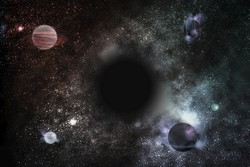New understanding of black holes
Einstein's theory of general relativity redefined Newton's law of gravity and established the space-time continuum of three space dimensions and one time dimension. It has interesting implications such as the 'bending' of the cosmos by very massive objects. It also predicts the existence of gravitational waves, propagating distortions in the geometry of space, and of black holes. Direct experimental connections to those theories such as gravitational wave detection and black hole production at the Large Hadron Collider (LHC) have fostered maturation of a new field within general relativity called numerical relativity. The EU-funded training network NRHEP (Numerical relativity and high energy physics) has promoted European excellence in this exciting new field. The network produced over 100 scientific papers published in top international journals, including 11 papers published in the prestigious Physical Review Letters. Participants have produced some of the best phenomenological values for the energy radiated – as gravitational waves – in the collision of two point-like particles at the speed of light, which is of relevance for TeV gravity scenarios being tested at the LHC. Another widely applicable result is that dark matter can pile up in stars and lead to much more stable configurations than previously thought. Important new results were obtained for spinning black holes. A long-standing problem of computing perturbations for Kerr-Newman (spinning and charged) black holes was solved. Two mechanisms were uncovered that can make Kerr black holes unstable in some alternative theories of gravity. A new type of rotating black hole was found, with potential astrophysical relevance, that circumvents the established belief that general relativity with simple, physical, matter sources only admits Kerr-like black holes as solutions. These new black holes can have very different phenomenological properties. The project has shown that particle collisions in the vicinity of rapidly rotating black holes can produce high-energy ejecta, raising the possibility that the collisional Penrose process may power gamma rays and ultra-high-energy cosmic rays. NRHEP made excellent progress in applying numerical relativity methods to the investigation of black holes, addressing questions inaccessible to other methods. Given the many advances in experimental methods and outcomes regarding high-energy physics, the project has paved the way to a significant impact for the EU in an emerging field that promises to revolutionise our understanding of the cosmos.
Keywords
Black holes, numerical relativity, gravitational waves, NRHEP, high energy physics

